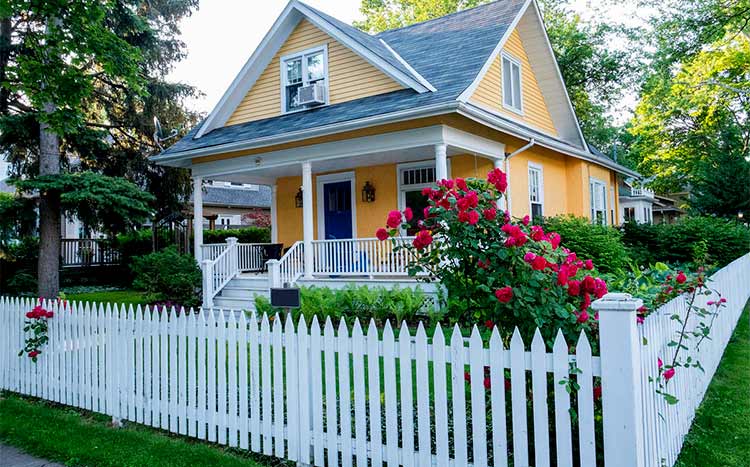A boundary fence is fundamentally a structure that delineates the division between two distinct plots of land. Such fences are prevalent in both residential and commercial zones throughout the United States and frequently serve as a point of contention among neighboring parties. Regarding boundary fences, what particular legal stipulations are enforced by South Carolina, and what prerequisites must be met prior to erecting one on your land?

There are no specific state-level laws on property line fences or boundary line usage in South Carolina. However, local city, municipality, town, or county-level ordinances may exist depending on where you live. The state does however have a set of laws regarding farm animals that touch on property boundaries.
What we cover
ToggleDo I Need A Permit To Build A Fence In South Carolina?
There are no laws requiring residents to obtain permits to erect a fence on their property in South Carolina. Permits to erect fences on private property are managed locally through municipalities, counties, or city departments in charge of building and zoning.
You need to find out depending on your location whether you need a permit and planning approval before you design and build your fence even if the plan complies with local fence regulations.
Cities that require some type of permit in South Carolina include North Charleston, Spartanburg, Columbia, and others. Some, like Greenville, SC, may not require a fence permit but will still require that you submit building designs for planning approval and also schedule an inspection to ensure compliance with the city’s building codes and standards.
You may be required to submit some documents in addition to a completed permit application to get approval. Some of the common documents attached to a permit application include your property’s plat showing property dimensions and boundaries, fence design, and location details.
Can I Replace an Existing Fence Without A Permit?
No, it is illegal to replace an existing fence without approval if local regulations require you to apply for a permit. The new fence must be taken through the same approval process as the existing one to ensure compliance with building codes or standards.
A point to note is that most South Carolina- licensed civil works contractors have copies of local building regulations or ordinances with them. They can offer invaluable input or guidance before you embark on any building project on your property. Most will also offer to process the permits on your behalf before they start working on your fence.
How Tall Can A Privacy Fence Be In South Carolina?
There are no standard state-level fence height requirements in South Carolina. Instead, the powers to specify fence and building requirements or make legislations are delegated to individual cities, towns, or counties. There may or may not be a maximum fence height clause in local building codes depending on your location.
The table below highlights maximum residential fence height requirements from select cities and towns in South Carolina as indicated in the respective fence or building codes of the ordinance.
| City, Town or county in South Carolina | Maximum fence height (Residential districts) |
|---|---|
| Charleston | 6 Feet (Front yards), 8 Feet (interior and Rear yards) |
| Greenville | 3 Feet (Front yards), 6 Feet (side and rear yards) Fences and walls above 30 inches in height within 5 Feet of the property line shall not be opaque and are subject to additional screening. Follow additional setback regulations in Greenville. |
| Columbia | 4 Feet (Front yard setback), 6 Feet (Secondary front yards), 7 Feet (rear yards), 5 Feet (Rear yard fences within 6 Feet of an adjacent structure). |
| Spartanburg | 3 Feet (front yards) 8 Feet (elsewhere on the property). |
| Florence | 4 Feet (Front yards), 6 Feet (side yards). Additional setback requirements may apply in some areas. |
Note: Fence heights are usually measured from ground level on the higher side of the fence or wall. Additional items such as lattice are included in the measurement. Refer to the specific code in your local fence ordinance for specific measurement and setback requirements especially for property line fences.
Who Owns the Fence on Property Lines In SC?
There are no specific laws governing property line fences in South Carolina. However, neighbors usually enter into legally binding easement agreements or boundary line agreements that define who owns which part of the fence and their responsibilities. If the fence was in existence when you bought the lot, then you can find out if there is an effective agreement in place.
Before you sign an easement or property line agreement, you should survey your land and properly identify the property line. Sometimes, an existing landowner might claim exclusive ownership of a fence if the fence is inches away from the marked boundary. In most cases, fences on property lines are jointly owned by adjoining landowners in South Carolina unless there is a land dispute.
How Do You Know Where the Property Boundary Is?
The recommended way to measure and mark a boundary line is to survey your land. A registered land surveyor in South Carolina can help measure, access existing plat maps (not older than 5 years), search local land records, and draw the property line.
You may also be able to know your property line from the plats drawn on your title documentation or land records accessible from the relevant city departments or council offices. Some cities also provide plat maps through online portals that you can access and read with the help of a registered surveyor. Lastly, inquire from your homeowner’s association if you have one in your neighborhood.

Can My Neighbor Build A Fence On The Property Line?
Neighbors can build a fence on the property line if there are no setback requirements or regulations at the local or neighborhood level preventing them. In most cases, adjoining landowners enter into an easement or property line agreement that has a clause on property line usage. In the agreement, you agree to split the costs of erecting a boundary fence if it is beneficial to both of you.
In the absence of a property line agreement, it is impossible to avoid disputes with neighbors who decide to use the property line as they wish. That said, it may be impractical to erect a fence that sits directly on the property line without encroaching on a neighboring lot. If a survey proves that the fence is encroaching on your land, then you could raise a claim on adverse possession grounds.
Can I Put Up A Fence on My Side of The Property Line?
Talk to your neighbors about your intentions before you erect a fence on the property line. If possible, you should sign a property line agreement with all adjoining landowners. This way, you will agree on how you can split costs on the new fence and how it will be used to avoid disputes down the line.
Another option is to identify the property line and erect your new boundary fence a few inches away. This way, you will leave a space between your lot and the neighbor’s and have exclusive rights to the fence. However, make sure you follow local building ordinances on boundary fences paying close attention to fence height.
How Much Does A Building Permit Cost In SC?
Fence permit fees (where required) vary based on the value of the project and where it is located. For instance, Charleston county does not charge any fees for building projects valued at $10,000 or less unless there is an inspection required which attracts a $50 fee. Your building contractor will be able to guide you on payments and where to obtain the permit if required.
Surveys and Estrays
With its deep agricultural roots, the state of South Carolina’s bulk of land usage law focuses on land usage concerning agriculture such as animal husbandry. For instance, a law touching on boundary fences focuses on animals that wander into neighboring properties otherwise referred to as estrays. Landowners are prohibited from hiding or using estrays to their advantage under the law.
What Is A Spite Fence?
Ever thought of building a fence that completely blocks off your neighbors or annoys them in some way? Such a fence is known as a spite fence and is illegal in most places in the country including the Palmetto state. Neighbors can sue you on private nuisance grounds or notify the authorities forcing you to demolish the fence. Residential fence height restrictions are specifically created to prevent spite fences.
South Carolina Boundary Fence Laws at A Glance
| Statues | Estray Definition | Estray Penalty |
|---|---|---|
| Estray Definition: S.C. Code Ann. 47-7-10 Penalties for appropriating estrays: S.C. Code Ann. 47-7-40 | Any domestic or domesticated animal that has been abandoned or found wandering onto some person's property. | If a person attempts to hide or use an estray for their own use, they are guilty of a misdemeanor. |
FAQ's
Who Owns the Fence Between Neighbors?
Neighbors in South Carolina can enter into property line agreements that have specific clauses on property line usage and allow them to share the boundary fences. This is because there are no specific laws on boundary fences in the state. In the absence of a property line agreement, it is advisable to erect your fence away from the boundary line.
What If A New Fence Is Blocking My View?
There are fence height requirements across cities and counties in South Carolina that prevent people from erecting tall or opaque fences. Notify the authorities or raise a private nuisance claim if a new fence is blocking your view.
Can My Neighbor Hang Things on My Fence?
Neighbors are not allowed to encroach into your land by hanging things on your fence. Notify the neighborhood association or relevant authorities and try to resolve the issue amicably. Always try to maintain a good relationship with your neighbors even in disputes.
What Requires A Building Permit In SC?
You may require a building permit to construct, repair, enlarge, alter, move or demolish any structure in South Carolina depending on your location and local building ordinance. Work with a licensed local contractor to ensure compliance.













